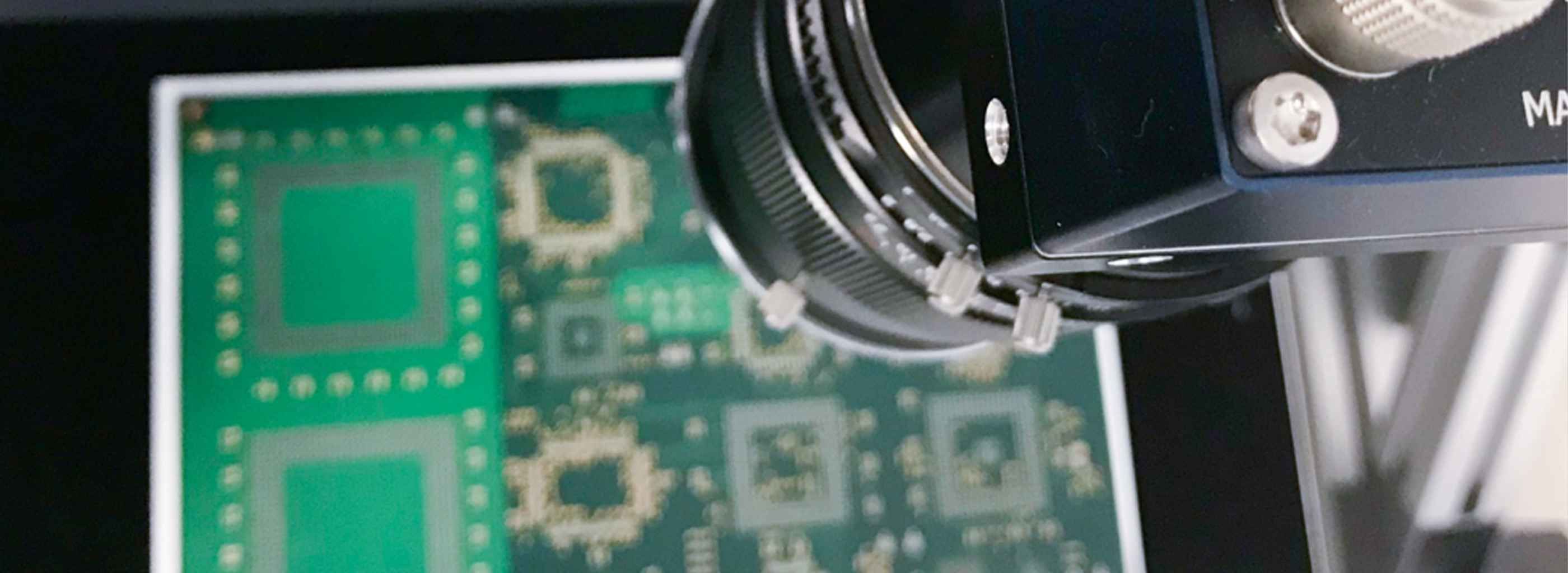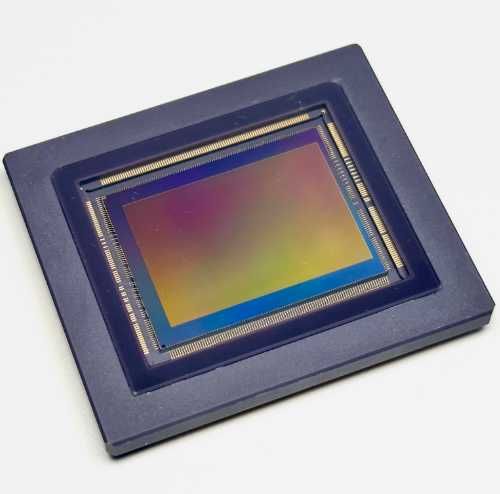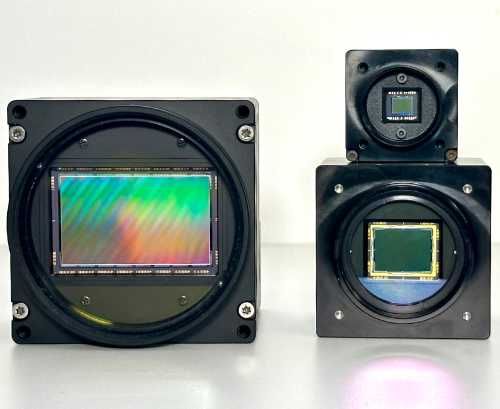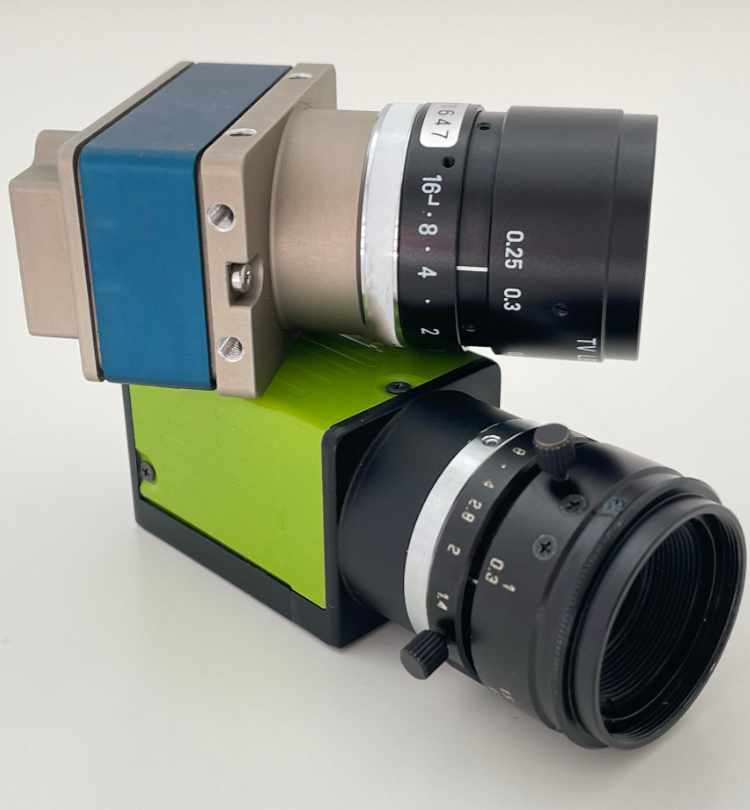





















Technological advances in sensor development are enabling the production of ever finer semiconductor structures. The general trend is to reduce the size of sensors and pixels so that more and more sensors can be cut from a wafer. This is possible because the sensitivity of the pixels is constantly increasing and the noise behaviour of the electronics is being optimised.
In most cases, a larger sensor with larger pixels is always the better technical choice, but it is also increasingly expensive.
However, as there are always technical limits, it is worth comparing cameras with different sensor and pixel sizes at the same resolution, especially when
Detailed information on camera quality (mainly sensor quality plus the quality of the readout electronics) can be obtained from the manufacturer's specifications according to EMVA 1288 standard.
Classic machine vision cameras have sensors of different sizes, depending on the camera and resolution used. The majority of cameras with smaller sensors are used with so-called C-mount or possibly CS-mount lenses. The C-mount connection thread has an actual diameter of 1 inch, i.e. 25.4 mm, and a thread pitch of 1/32 inch.
The sensors used in standard cameras are much smaller, ranging from 4 to 16mm in size. These sensor sizes are also given in inches. For example, the 1-inch sensor has a 16mm diagonal.

The inch size specifications for CCD and CMOS sensors can only be explained by history: TV camera picture tubes were used until the mid-1980s and were long superior to the CCD or CMOS sensors invented in the late 1960s.
The actual image converter of the tube cameras was housed in a glass vacuum tube, and the various imaging tubes were categorised according to, among other things, the outer diameter of the glass bulb. The diagonal of the light-sensitive surface inside the tube was naturally smaller, about two-thirds of the outside diameter. The CCD sensors that were to replace the cathode ray tubes had to cover exactly this area. A CCD with a light-sensitive area equivalent to that of a 1/2-inch tube was therefore called a 1/2-inch sensor, even though this does not correspond to the actual dimensions of today's standard CCD or CMOS sensors.
Today, industrial cameras with resolutions of 640x480 pixels usually use 1/3" sensors, while cameras with 2 to 5 megapixels use 1/2" sensors. Cameras with 5 or 8 megapixels usually have 2/3' sensors, and cameras with 12 to 24 megapixels often have 1' or 1.2' sensors.
There is a general trend towards smaller sensors in the mass camera market. At the end of the 1980s, some standard VGA sensors were 2/3' in size, whereas today they are only 1/3'. This miniaturisation is the result of improved manufacturing processes that have resulted in smaller photosensitive areas.

If you have a choice between a larger and a smaller sensor for a camera model, we recommend that you choose the larger sensor if you are making precision measurements or ultra-fine surface inspections, for example:
High-resolution area or line scan cameras also use much larger sensors, several centimetres in size. The dimensions of these sensors are generally not standardised and depend on the resolution and pixel size of the sensors. Anything is possible, limited only by budget.
A line scan camera with 2048 pixels and a pixel size of 10µm has a line length of 20.48mm, with a pixel size of 14µm the sensor is already 28.6mm long. From a sensor diagonal of 20mm, the C-mount lens mount can no longer be used.
These cameras then typically use the Nikon bayonet (F-mount) or M42 to M72 as lens mounts. Only now can high-resolution sensors with large pixels be used to build line scan cameras with up to 12k pixels or area scan cameras with up to 16 million pixels.
High-resolution area scan cameras with high-resolution sensors of up to 250 megapixels now also have very large image converters. These often require cameras with an M42 or M72 mount thread.

As sensor miniaturisation continues, pixel sizes are getting smaller. Sensors in consumer cameras (8 to 12 megapixels for 200 Euros) today typically have pixel sizes of 1.7 µm, which means that the light-active area per pixel is only about 3 µm2. This leads to higher sensor noise in sub-optimal lighting conditions. This is completely unacceptable for camera quality control.
Modern industrial MV cameras (C-mount) with resolutions from VGA to 24 megapixels generally have pixel sizes of 2.74 to 3.45 µm (Sony Pregius S Gen. 4, Sony Pregius Gen.2) and therefore deliver much better signal results. If you need low noise images and accurate measurement results, make sure the sensor pixels are as large as possible, even if these cameras are a little more expensive!

This specification describes how many electrons a pixel element can hold until it is fully saturated. For example, a 5.5µm pixel can hold approximately 20,000 electrons, and a 7.4µm pixel can hold approximately 40,000 electrons.
However, the larger the full-well capacity, the better the maximum signal-to-noise ratio. Consumer cameras with a pixel size of 1.7 µm only need about 1,000 photons to reach pixel saturation. When digitising at 8, 10 or even 12 bits, other noise effects (photonic noise, digitisation noise, dark noise) can already take on significant dimensions, overlay the signal and thus negatively affect the image.
Sensor dynamics also suffer from small pixel structures. The detection limit is limited by the thermally induced dark noise of the sensor. Only when the number of electrons generated by the light exceeds the value of the dark noise can the sensor detect anything at all. The dynamic range of the pixel is the ratio of the capacity of the full well to the dark noise.
Small pixels produce much noisier images in low light than large pixels, and image dynamics are reduced. Noise is disruptive to the application. Use bright lighting or LED flash controllers to have more light available!
Many 'megapixels' do not help in the long run. Small pixel structures also require high-quality optical imaging, i.e. high-resolution lenses. Otherwise, the result will be blurry images with lots of pixels but no real structural detail.
Small camera pixels also require extremely precise mechanical alignment of the sensor, as the depth of field is significantly reduced. The tilt of a sensor with 5µm in the housing may only be half as large (+/1 15µm @ aperture=2.8) as with pixels with a structure size of 10µm. So again, make sure you use high quality suppliers, otherwise the best sensor in the camera will be of no use to you.
Vision-Doctor.com is a private, independent, non-commercial homepage project and not a technology provider or system integrator. Suitable technologies and further professional support can be obtained from the companies & partners listed below.
If necessary, I will be happy to provide a quick recommendation, contacts and brief information.
